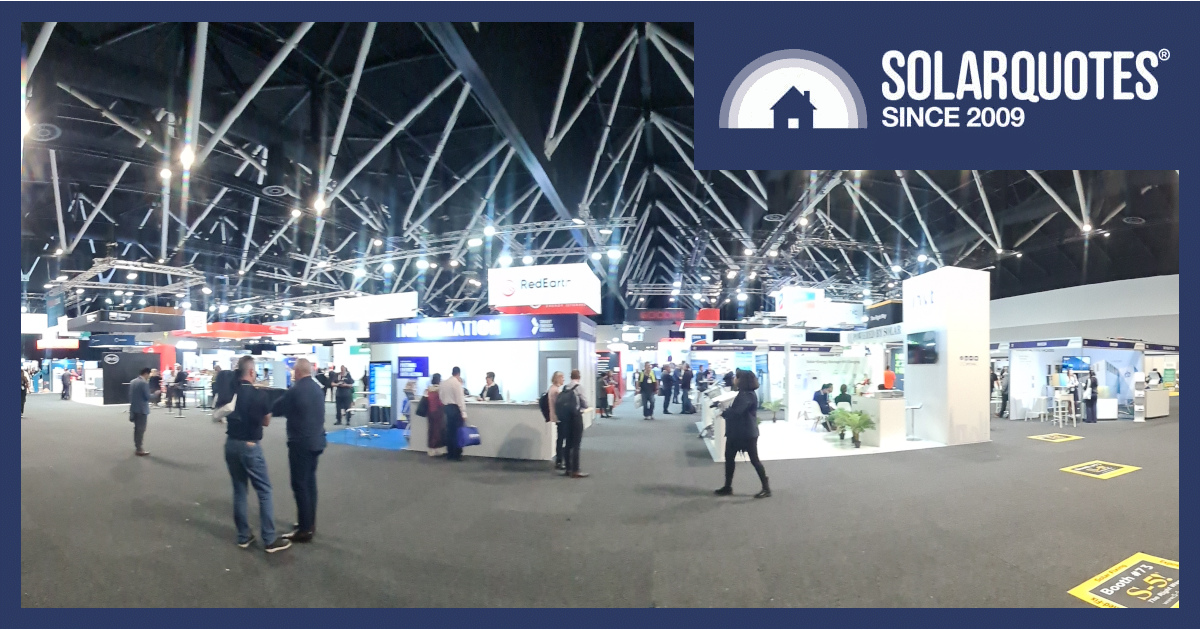
All of this energy industry technology and here’s me with a flat phone battery.
Dear reader, I’ve taken the plunge and weathered another trade show, Smart Energy 2023, so you don’t have to.
Peeling Back the Curtain: What Really Happens at Solar Trade Shows?
Solar conferences and tradeshows play a crucial dual role for installers – like me – who attend. On the one hand, it’s impressive to see the vibrant displays, perfectly assembled panels, and pristine inverters minus the messy wiring, but let’s cut to the chase: the primary lure for installers is the pursuit of Continuing Professional Development (CPD) points.
For some, CPD is a necessary evil to maintain their Clean Energy Council (CEC) accreditation – a must-have for installing solar systems. Some of these points can be conveniently accumulated from home through online courses like those offered by their local electricity networks (DNSPs). The problem is that the CEC insists you get 100 points, and in many cases, the money-hungry CEC charge money for those points. The public should be under no illusion: the CEC is a private company pretending to be a public authority.
The manufacturers are our saviours, though. They run technical courses which have been vetted and approved by actual registered training organisations. So while they promote their product and its advantages, they also throw in broader industry knowledge to keep the tradespeople on the ground up to date. Manufacturer training is something that all electricians should do, honestly.
So, when you spot the electricians and tradies making their way through the conference, they’ve taken a day off from their demanding rooftop jobs (which comes with its own expenses) to attend sessions in the smaller side rooms. Their goal is to learn as much as possible and, of course, to earn those precious CPD points.
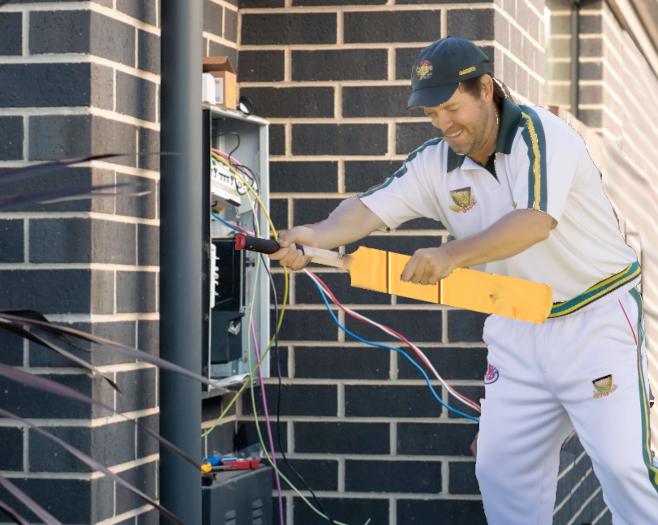
We didn’t see these guys at the technical presentations for some reason. It’s a good reason not to trust a superannuated sports star to sell you solar.
The Trade Show Dichotomy: Education and Extravagance
On the other end of these trade shows are the grand presentations by what I’m terming ‘The Energy Illuminati’: the CEOs, the experts, the scientists, and the ministers (who annoyingly always seem to bugger off before you can ask questions).
Even star power shows up, like cricket captain Pat Cummins with his “Cricket for Climate” project. That bloke has much more credibility than the has-been cricketers pushing cheap rubbish solar on TV.
Last but certainly not least, we also heard from Saul Griffith, chief scientist with Rewiring Australia. I’m pleased to say I met him and had a few words, but I didn’t geek out enough to have my laminate signed or get a selfie. In retrospect, that would have made a good image to post here. I should have lined up.
Takeaway #1: Urgent Need for Fuel Standards
Australia is on the brink of becoming a dumping ground for obsolete vehicle technology. Manufacturers prioritise countries with strict emissions standards, supplying them with cleaner, cost-effective models. We, as a nation, could save billions by updating our laws to match the reality observed overseas for years.
Applying a fleet average fuel consumption target to imports will force the particularly recalcitrant manufacturers to shift toward electrification, not just better fuel efficiency in their legacy models.
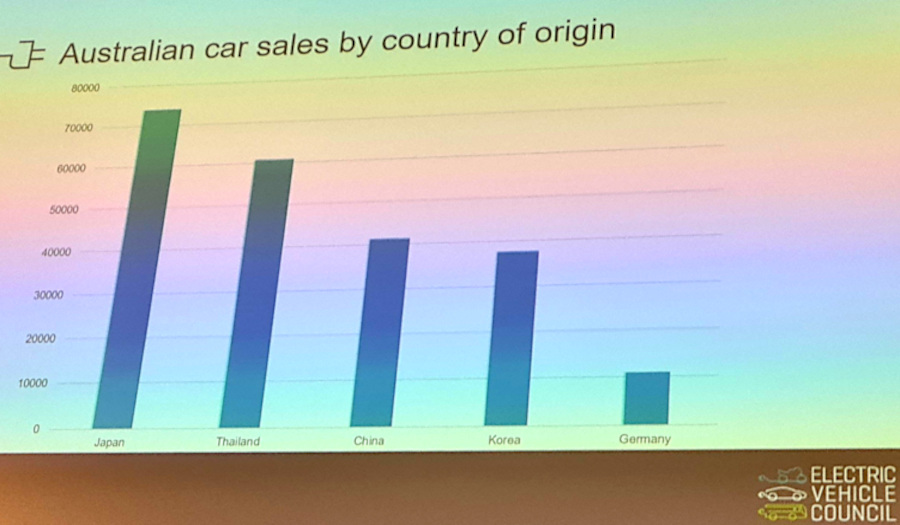
Thailand is where many brands and models of the dreaded dual cab ute come from.
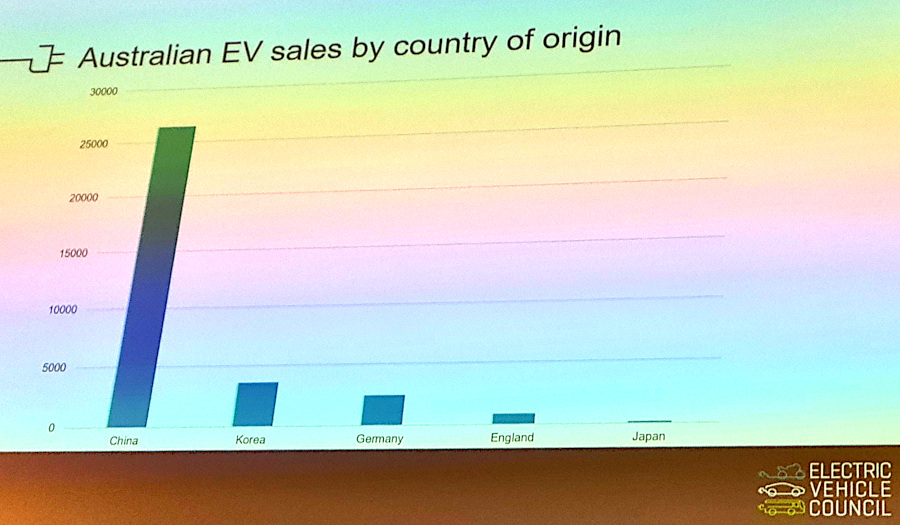
Despite being the market leader in current technology, one economic superpower has missed the bus in the emerging EV segment.
Takeaway #2: The Recurring Theme is Storage, Storage, Storage
Whether it’s large-scale grid issues or individual consumer concerns, the battery is the shining star of any energy industry forum these days . But, we should also not overlook demand response, a tried and true method already saving us for years.
While storage will be critical going forward, the cheapest way to reduce costs is to reduce what you’re using. Getting paid to turn things off is a perfectly sensible approach, even if the (non)experts in the comment section of your favourite social media are screaming, “we’ll all be roooooned” if you dare suggest they surrender a little control of their air conditioner for the greater good.

The basic conference toolkit includes a QR code for swapping email, cards for when that fails and a spare phone battery.
Takeaway #3: Electrification Needs Better PR Than Gas
As I mentioned earlier, Saul Griffith now has to deal with groupies. In a matter of months, he’s become the electricifcation figurehead by speaking, writing and lobbying in a way that’s digestible by technicians, laymen and even MPs.
A real nugget I found in his rapid-fire presentation was the electrification of his home postcode. It’s a pilot program we must embrace in every other postcode as we ReWire Australia.
Around $20 million is spent annually on energy in postcode 2515. Three-quarters of that come from fossil fuels (cars and gas in the home), and one-quarter of it from grid power.
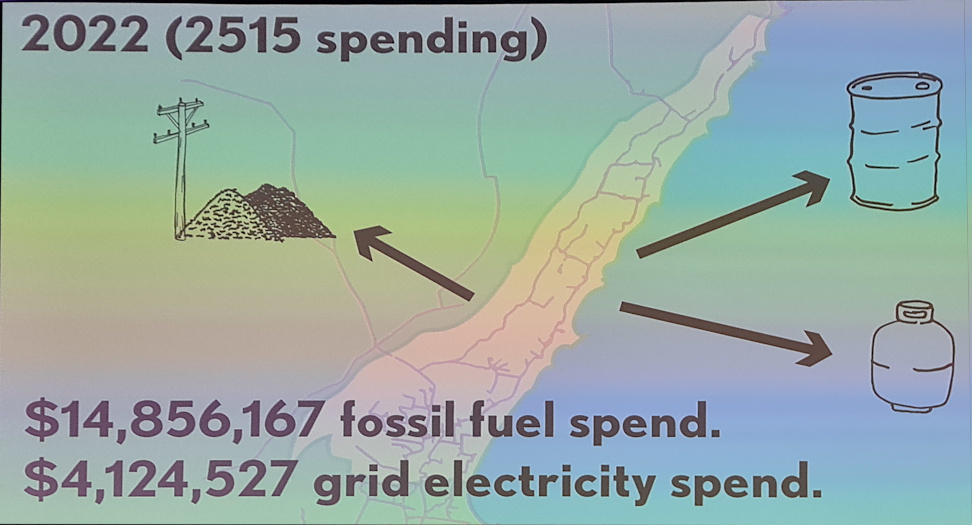
To clarify, in the year 2022, spending on energy was around $20,000,000 in the postcode 2515.
“Most of that money is being spent at the one petrol station in the community, where they also sell you nicotine and sugar – three things that can kill you in one place,” Griffith says.
“Fast forward to the future if we we can easily generate at least two thirds and potentially all of our electricity if we fully utilize our rooftop and community assets.”
“We’d be creating a million and a half dollars a year in local electrification to labour about 25 jobs. We’d be saving about $21 million a year.”
“The real point is if we are not spending that money at the petrol station, we’re now spending that money and investing in our communities, This is how we create an unbelievable number of local, real jobs everywhere in the country.”
Decarbonisation Is Urgent
I’ve had more than a passing interest in energy and climate since social studies in year 6. While jetting off to a Sydney conference seems wasteful, I hope the knowledge I share with my readers makes it worthwhile.
“Net zero by 2050 isn’t going to cut it anymore. What we have to achieve is absolute zero by 2040.”
Looking at the Future Through a Farmer’s Lens
Decarbonising a 300-horsepower tractor won’t be easy, but it is possible. And we should electrify it for one reason: Australia imports around 90% of its transport fuel. There’s a fortnight’s supply onshore, six weeks if the boats already under sail make it here.
Electrification will harvest fuel from your rooftop and giant wind turbines instead of paying through the nose to truck it in from an extremist theocracy, via a Singaporean refinery, foreign-flagged ship & tax dodging multi-national fuel distributor.
Electricity is one-third the price of petrol, even less if you have your own solar. In fact, if you use the right retailer offering real-time wholesale prices, there are already times you can be paid to charge your car or house battery. So with a 40kWh battery that comes with wheels and a Nissan badge, coupled to a decent solar system and a charger that goes BOTH ways, you suddenly have a system that soaks up cheap power around midday and also runs your fridge & cooks tea during the expensive evening peak. It’s already here, and so is the surplus clean energy that needs storing.
Rather than watching oil barons build snowfields in the freaking desert, why don’t we keep our money here and do something useful with it? We should be calling out the gas industry for running nonsense and fear campaigns about the future of the Aussie BBQ, because, at the heart of it, electrification is a simple and economical process that we must make easy. Infuriatingly our friends from big gas are whacking some customers with a regulated $1000 bung just for disconnections.
The problem, as I see it, is that even electricians I meet are readily spruiking the gas industry disinformation.
And when you’re at a BBQ, you shouldn’t be fed disinformation by your trusted local tradie.

 RSS - Posts
RSS - Posts



Love it – BUT – I think that every one involved in the energy business should
read Vaclav Smil’s book “How the World Really Works” – it’s an eye opener, (even if his initial chapter on energy gets a tad disjointed). Smil (Uni of Manitoba) has been an energy analyst for decades, and has a really good grasp of the realities we face.
I’d call Vaclav Smil “unrealistically pessimistic”. But he’s not wrong that slashing greenhouse gas emissions is a bloody big job.
The record coldest Christmas eve in Winnipeg was -47.8 C.
Being told regularly that exposed flesh will freeze in 2 to 5 minutes if he goes outside might be making him pessimistic.
hmmmm, the CEC are they publicly listed in Palmero Italy?
Battery storage and vehicle electrification via battery storage has all the hype of a saviour to our planet. But in this rush to storage energy could we be creating another environmental disaster? I see little to no research on the recycling of lithium batteries. Should we be rushing head first, like a bull at a gate, using up finite mineral resources but with no idea of how to recycle these batteries?
Hi. While still in its early stages in Australia, batteries can definitely be recycled:
https://www.solarquotes.com.au/blog/envirostream-battery-recycling-mb1342/
But even if they weren’t practical to recycle, it would still be much less of an environmental problem than continuing to use fossil fuels.
You really should not be using the Leaf EV and Quasar solution and upholding it. There is one single installation in SA and a trial of 50 cars in the ACT and Quasar have withdrawn the unit from Sale in Australia whilst the next version is developed – so whilst it is a technically viable solution – it is not a commercially available one.
Quasar have not indicated when the replacement unit will be released, nor pricing, nor the timeframe for it to go through Australian certification (which is shame as i have Leaf and would love to do this if the box was $5K not $10K
Anthony Bennett,
You included in your post:
Evidence/data I see indicates absolute zero by 2040 won’t cut it anymore either.
See the Hansen et. al. pre-print paper titled Global Warming in the Pipeline, latest revision at:
https://twitter.com/DrJamesEHansen/status/1659567180055298050
Barring multiple nuclear weapons airbursts, major volcanic eruptions, and/or major meteor surface impact event(s) here on Earth, compelling evidence/data I see indicates the Earth System will inevitably breach the +1.5 °C global mean surface temperature threshold (relative to 1880–1920 mean), and likely do so before 2035.
It is now slightly more likely than not that 2023 becomes the warmest year in the instrumental record (56% chance).
https://twitter.com/RARohde/status/1658869195541446683
A first (temporary) breach of the +1.5 °C global mean surface temperature threshold could be as early next year (2024).
https://twitter.com/BBCBreaking/status/1658776307742769152
Professor Eliot Jacobson tweeted on May 20:
https://twitter.com/EliotJacobson/status/1659578806242529282
• There is NO CARBON BUDGET REMAINING for a safe climate for humanity.
• Overshooting the +1.5 °C warming threshold is not safe.
• Decarbonisation is not enough.
• Reducing the level of atmospheric GHG concentrations by carbon drawdown is now vital.
• Unfortunately, it seems large-scale carbon drawdown technologies don’t yet exist.
The Australian EV sales by country of origin slide is somewhat misleading. Figures elsewhere say 59% of 2022 EV sales were Tesla, an American brand, but Australian gets the made in China version. Polestar is a Swedish brand but again the cars Australia imports come from China. And rounding out the ‘Big 3’ is BYD which actually is a Chinese company manufacturing in China and dumping EVs on Australia.
There’s also Chinese brands MG and LDV, as well as European companies manufacturing in China such as BMW and Volvo.
Noticing a pattern?
Perhaps Japanese and Thai manufacturers who dominate Australian car sales simply aren’t as interested or invested in the EV market?
Regarding the 2515 2022 spending on fossil fuel and grid power. How’d they arrive at their figures? And does the jobs created via electrification figure factor in the jobs lost by ending fossil fuel? Here for instance the petrol station staff would be out of work, as would the gas delivery guy. The mechanics may go out of business too as EVs are expensive and incredibly complex unlike nice simple (relatively) cheap traditional vehicles. (I’m paraphrasing and obviously some folk here will dispute the claim). So all those jobs lost, would any be gained? Not really. Perhaps some out of town technician to periodically check up on the self serve electricity (EV recharge) station. Maybe a fraction of a staff member in some foreign call centre somewhere, maybe? But I don’t live in 2515 and the situation here is presumably quite different to there.
If BYD was dumping cars in Australia it would mean they were selling them at a lower price here than in China. Unfortunately, they’re not doing that. Because Australia has no domestic EV manufacturing I wish overseas producers would dump all over us. Unfortunately, that’s not going to happen.
Just a little puzzled about Saul’s figures? With a stated $19m energy spend in his postcode including $14.2m on fossil fuels and $4.8m on grid power which last time I looked in NSW where his postcode is about 75% from coal fired generation.
I get that a changeover to PV would involve the $1.5m in PV jobs to keep things going and keep those licensed electrical contractors busy and even discounting the initial cost of all that PV equipment where does the $21m of savings come from?
How do you get $21m of savings which is more than the original $19m spend?
On Saul’s web site there is a lot of good stuff about the huge reductions in energy consumption available if everything goes electric. The reality is that without huge storage investments how can the heaters and lights be kept on in winter as well as having all the cars charged and ready to go?
His model is to avoid transmission costs according to his web site.
I am all for reducing CO2, by all possible means but short of a Snowy 3 located above where he lives and pumping the Pacific Ocean uphill I would like to know how the storage issue is to be resolved?
Just asking?